How to Use AI Image Generator: Create Stunning Art Easily
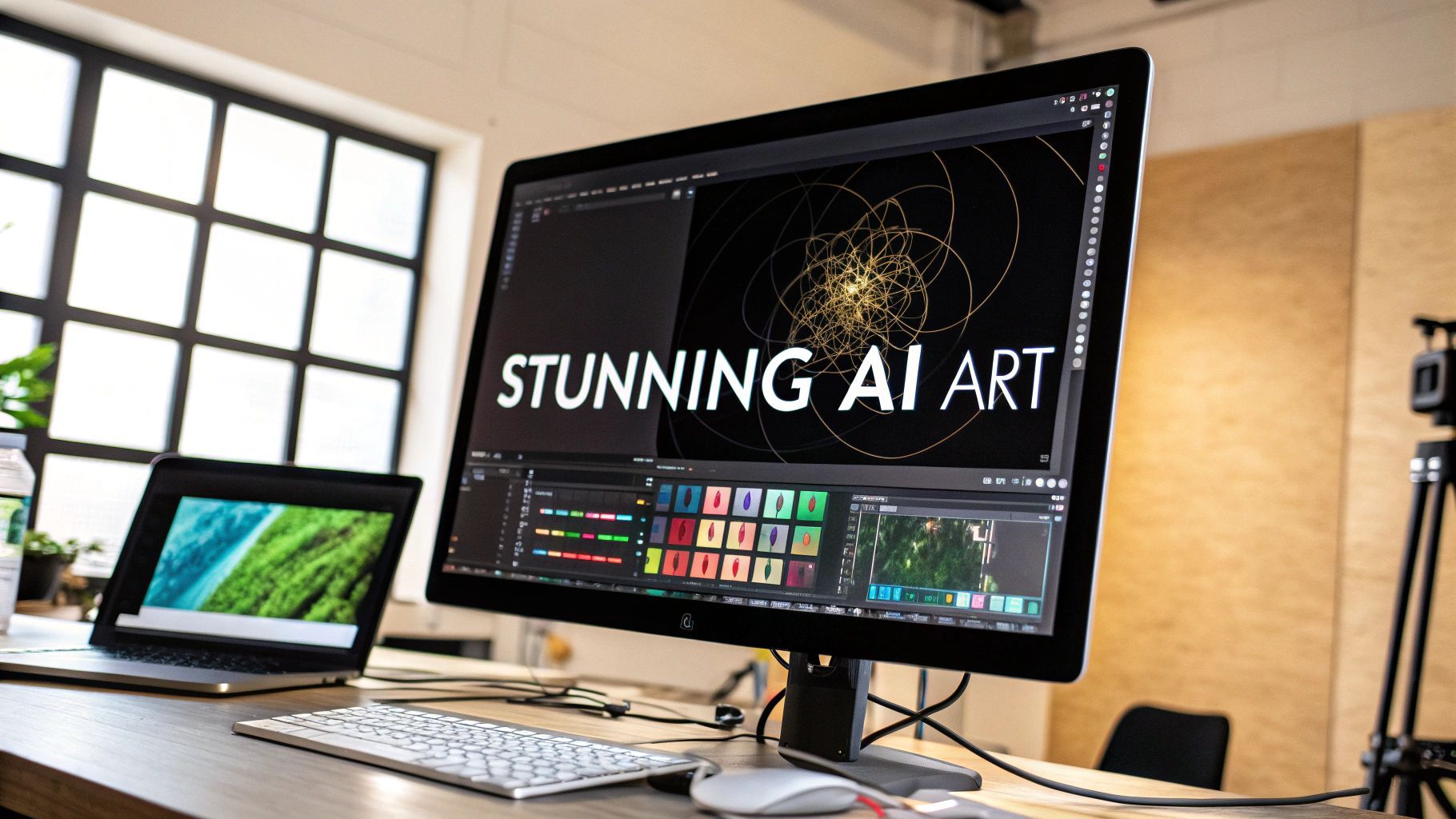



Unlock your inner poet. Learn how to make words rhyme with our guide on rhyme schemes, word selection, and writing techniques to craft perfect lyrics.
So, you want to make words rhyme? It's not just about matching the last few letters. At its heart, rhyming is about matching sounds, starting from the final stressed vowel in a word. This is where the magic happens—it’s a blend of creative spark and a solid grasp of how sounds work together to create something that feels just right.
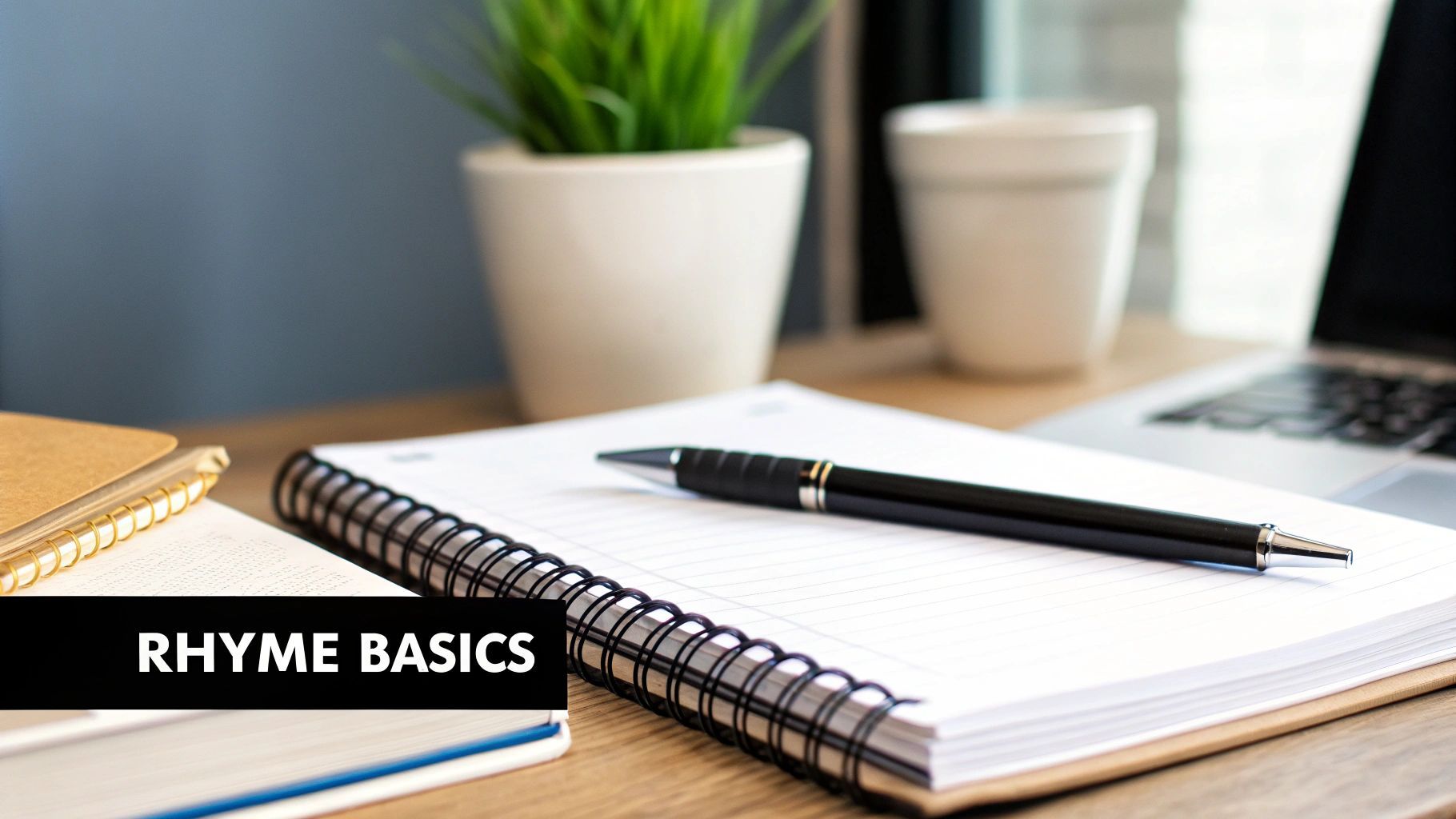
Ever wondered why some rhymes just work? They land with a satisfying click, while others feel clunky, like trying to fit a square peg in a round hole. The secret sauce isn't just finding words that sound alike; it's about understanding the subtle dance of sounds that makes a rhyme truly connect.
Think of it less as a rigid rulebook and more as a powerful tool. A good rhyme creates rhythm, evokes emotion, and makes your words stick in someone's head.
At its core, a rhyme is just a simple repetition of similar sounds. But that simple concept is the engine behind everything from Shakespeare's sonnets to today's biggest hip-hop tracks. Our brains are hardwired to love patterns, and a well-placed rhyme delivers a tiny, satisfying burst of harmony that just feels good to hear.
The first step to becoming a true wordsmith is to move beyond the most obvious pairings. Sure, "cat" and "hat" get the job done, but exploring different types of rhymes is what unlocks a whole new level of creativity. This is what separates the amateurs from the masters.
Here's a quick rundown of what you'll be playing with. Think of these as different colors on your lyrical palette.
This table is a quick reference guide to the most common types of rhymes. Get familiar with them, and you'll start seeing and hearing them everywhere.
| Rhyme Type | Definition | Example |
|---|---|---|
| Perfect Rhyme | The classic rhyme. The final stressed vowel and all following sounds are identical. | bright / night |
| Slant Rhyme | Also called a "near rhyme." The words have similar but not identical sounds. | shape / keep |
| Eye Rhyme | Words that look like they should rhyme on paper but don't when you say them out loud. | love / move |
Once you start using these different types, you'll find your writing has more texture and sophistication.
This isn't some new-fangled idea, either. If you look back at the history of English poetry, you can see a clear shift from simple, common pairings to more surprising and inventive ones. Back in the 16th century, pairs like ‘me/thee’ were all the rage. Fast forward to the 19th century, and poets were on the hunt for unique rhymes that could stand on their own as clever wordplay. If you're a history buff, you can dive deeper into this evolution of rhyming tastes over at Prelude Magazine.
Key Takeaway: A great rhyme does more than just sound good—it adds another layer of meaning. When you connect two words with a rhyme, you're creating a subtle link between their ideas in the listener's mind. Use that power to emphasize your point and drive your theme home.
Alright, enough with the theory. Let's get our hands dirty and actually start making words rhyme. The real work begins when you start stocking your creative toolbox. You don't need a ton of fancy gear, but knowing the right tricks and having a few resources on hand can be the difference between a day of frustrating dead-ends and a genuine lyrical breakthrough.
The most classic tool in the shed? A good old-fashioned rhyming dictionary. I know, I know—it can feel like cheating. But trust me, it's not. It's research. The pros use them all the time to dig up options they’d never think of on their own. Think of it less like copying someone's painting and more like expanding your color palette.
But a dictionary will only take you so far. The real magic happens when you learn to think around a word. Don't get cornered trying to find a perfect rhyme for a stubborn word like "orange." Instead, flip the problem on its head: can you rephrase the line so it ends on a word that’s a little more... cooperative?
Sometimes, the best rhyme isn't the most direct one. This is where a thesaurus becomes your secret weapon. Let's say you're stuck on the word "brave." A quick thesaurus search might spit out "bold," "strong," or "daring." And just like that, you've unlocked brand new rhyming doors: "cold," "along," and "caring."
This indirect approach is a game-changer for keeping your writing fresh and steering clear of those tired clichés. It forces you to put the meaning first and the sound second, which almost always leads to more powerful and authentic lines.
Here's a little exercise I use to sharpen this skill:
Create Rhyme Families: Start with a simple, common word. Let's use "light." Brainstorm Direct Rhymes: First, jot down all the perfect rhymes that pop into your head: night, sight, bright, fight, white. Easy enough. Find Synonyms: Now, open a thesaurus and look for synonyms for "light." You might find glow, gleam, shine, beam, ray. Build New Rhyme Chains: The fun part. Find rhymes for those synonyms: glow/so, gleam/dream, shine/divine, beam/seem, ray/day.
Boom. That simple process just turned one potential dead-end into five new creative pathways. You've exploded your options.
A great rhyme feels inevitable but not predictable. It should surprise the listener while simultaneously feeling like the only word that could have possibly fit. That’s the balance you're aiming for.
To really get good at this, you need a system. This little flow chart breaks down how to identify and nail a rhyming pattern in your own work.
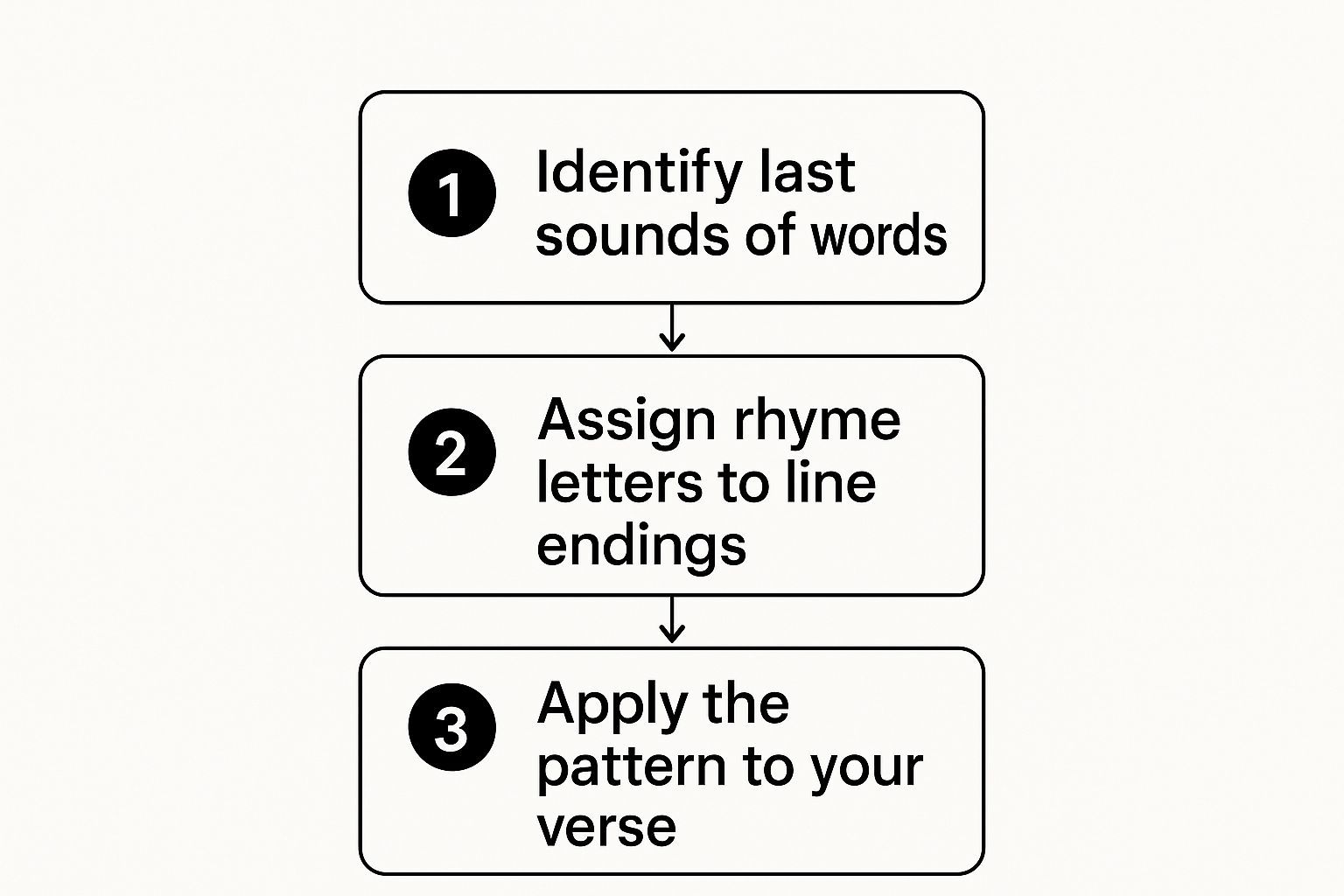
Seeing it laid out like this turns a fuzzy, abstract idea into a concrete method you can start using right away.
While the classic methods are fundamental, don't sleep on the tech we have today. Sometimes you need more than just a list of words; you need a spark for an entire line or a fresh phrase. This is where AI can come in and act as a pretty brilliant creative partner.
For anyone writing song lyrics or rap verses, playing around with an AI rap generator can be an incredible way to blast through writer's block. It can spitball rhymes, rephrase lines for you, and even generate ideas in a specific style, acting like a brainstorming buddy who never gets tired.
The goal isn't to let the machine write for you. It's to use it to ignite your own creativity. It can show you connections you might have missed, helping you track down that perfect, elusive rhyme that just ties the whole piece together. When you combine these old-school techniques with new-school resources, your rhyming toolkit becomes seriously powerful.
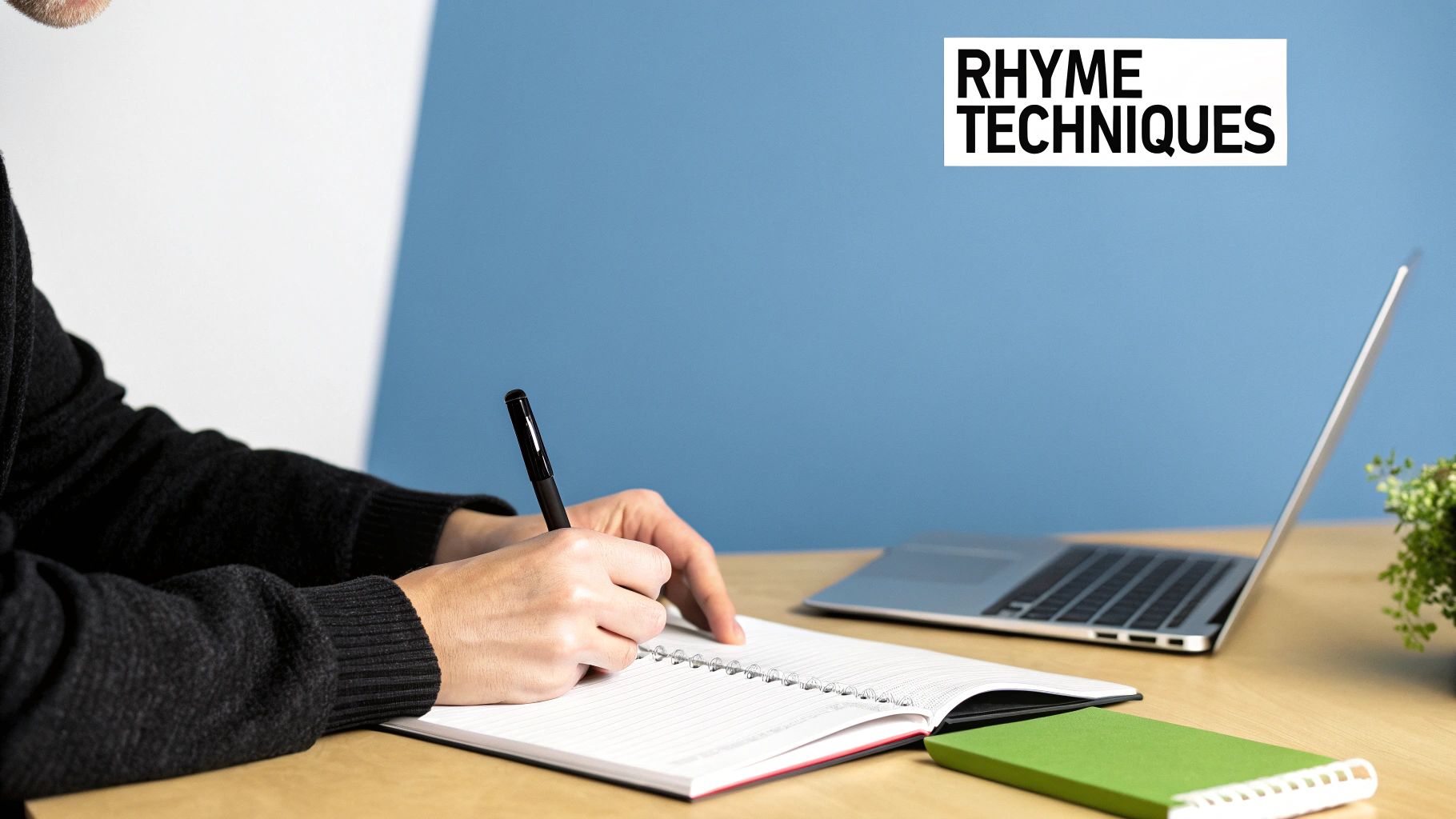
Finding a killer rhyme is only half the battle. The real magic happens when you start arranging those rhymes into a pattern. This structure, what we call a rhyme scheme, is the invisible blueprint of your song. It’s what dictates the rhythm, the flow, and ultimately, the entire emotional punch of your lyrics.
Think of it like building with LEGOs. Your rhyming words are the individual bricks. But the way you stack them—the rhyme scheme—determines whether you end up with a simple little house or a sprawling, intricate castle.
For instance, the classic AABB scheme, where two back-to-back lines rhyme, creates a really simple, catchy rhythm. It's incredibly predictable, which is exactly why it’s perfect for nursery rhymes and pop bangers. It gives the listener's brain an easy path to follow.
To really make your words land, you need to understand how different patterns feel in practice. Let's break down some of the most common schemes with examples you’ll probably recognize instantly.
AABB (Couplet): This is the most straightforward pattern out there. "I'm waking up to ash and dust (A) I wipe my brow and I sweat my rust (A) I'm breathing in the chemicals (B) Gasping for air" (B - implied rhyme) (Imagine Dragons - "Radioactive") ABAB (Alternate Rhyme): This one feels a bit more sophisticated, a little less sing-songy. "I'm on the pursuit of happiness and I know (A) Everything that shine ain't always gonna be gold (B) Hey, I'll be fine once I get it, I'll be good" (A - a near rhyme, which totally counts!) (Kid Cudi - "Pursuit of Happiness")
These patterns aren't just dry poetic theory; they are the absolute bedrock of modern music. Rhyme is a huge deal in contemporary genres like rap, where it creates this incredible dance between words and rhythm. Interestingly, Stanford research notes that the rise of rhyme in Western poetry happened as languages shifted to be more accent-based, making it a killer tool for emphasizing rhythm.
Pro Tip: Don't be afraid to break the rules. Seriously. Sometimes the most powerful moment in a song is when you build up a pattern and then deliberately break it, completely subverting the listener's expectations.
The rhyme scheme you choose is a powerful mood-setter. A simple AABB can feel light and playful, while a more complex pattern can build tension or create a more serious, contemplative vibe.
Take the ABBA scheme, for example. It creates a sense of enclosure by "trapping" the B rhymes inside the A rhymes. This can make the verse feel more thoughtful, or even a bit claustrophobic, depending on the words you choose.
And don't forget about internal rhymes—rhymes that pop up inside a single line. This is a slick move to add a sudden punch of musicality. Edgar Allan Poe was the king of this: "Once upon a midnight dreary, while I pondered, weak and weary." It adds this little burst of complexity right where you least expect it.
If you're putting together a full song, playing with these schemes is how you craft verses that feel distinct from your chorus. Need some fresh ideas? Our guide to the best AI music generators covers some cool tools that can help you experiment with lyrical structures. At the end of the day, getting a grip on structure gives you total control over your song's emotional journey.
Nothing kills a killer line faster than a clunky rhyme. We've all cringed at it: a beautiful, heartfelt thought gets completely mangled just to land a rhyme that feels awkward, forced, or worse... cheesy. This is easily the biggest mistake I see new writers make—they sacrifice the entire point of their message just to make two words sound alike.
Let’s get one thing straight: the rhyme is there to serve the idea, not the other way around. If you find yourself twisting your message into a pretzel to fit a rhyme, stop. Just stop. A good rhyme should feel like it was always meant to be there, not like you shoehorned it in.
A dead giveaway that you've fallen into this trap is relying on rhymes that are completely worn out. They’re the clichés everyone has heard a million times before.
You know exactly which ones I'm talking about. They’re the first rhymes that pop into your head, and while they feel easy, they make your writing sound like a hundred other things.
Here are a few of the usual suspects to keep on your radar:
fire / desire: The go-to for every dramatic ballad since the beginning of time. love / above: It’s sweet, sure, but it’s been done to death. pain / rain: The classic sad-song combo. It rarely feels new. heart / apart: Another breakup anthem staple that's incredibly hard to make feel original.
Now, I'm not saying you can never use these. But if you do, you'd better have a darn good reason. Maybe you're using it with a bit of irony or putting a clever spin on it that winks at the listener. Otherwise, it just sounds like you grabbed the first thing you found in a rhyming dictionary.
A truly great rhyme feels like a surprise and an inevitability all at once. It should click into place perfectly, making the listener think, "Of course! What else could it have been?" without ever seeing it coming.
This same principle applies to what we call "false rhymes" or "eye rhymes." These are words that look like they should rhyme on the page but sound just a little... off. Think love and move. The spelling is similar, but the vowel sounds clash when you say them out loud, creating a clunky, jarring moment that yanks your audience right out of the experience.
So, how do you avoid these traps? It's simple. Read your work aloud.
This is the ultimate sniff test. Your ears will immediately pick up on the weird phrasing and clumsy rhymes that your eyes gloss over. This one habit will help you make sure every line flows and every rhyme lands with a satisfying click, not a thud.
For example, if you're writing something personal, like in our guide to crafting creative happy birthday wishes, a forced rhyme can completely kill the genuine sentiment. By listening to what you've written, you can ensure your rhymes actually elevate your message and make it stick.
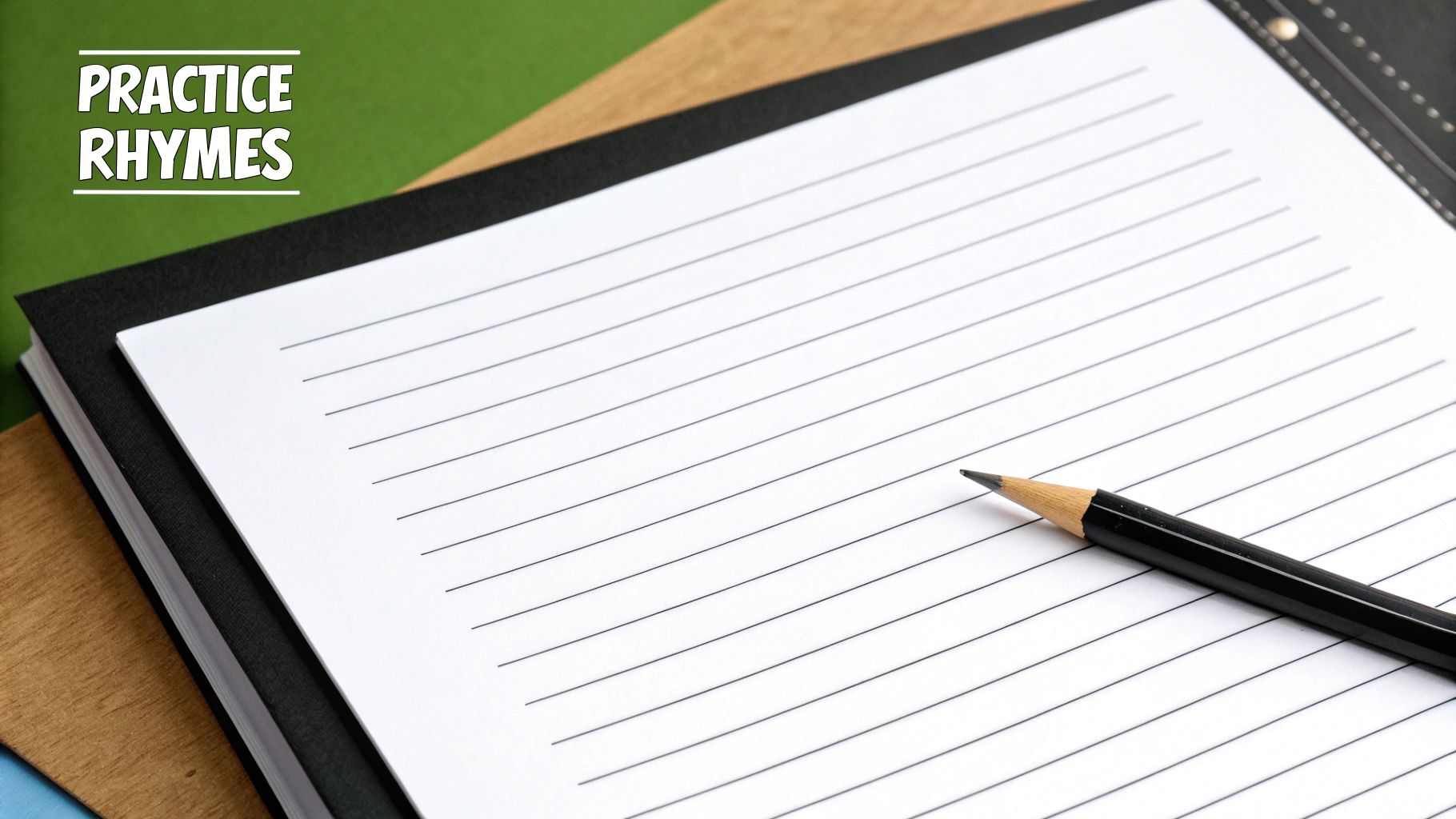
Let's be real—even the pros get stuck. You've got a killer idea and a line that sings, but that one perfect rhyme is playing hard to get. This is the moment when an AI tool stops being a tech gimmick and becomes your secret weapon, an endlessly patient brainstorming buddy who never gets tired.
Forget those dusty, old-school rhyming dictionaries. Today's AI assistants do way more than just list words that sound alike. They can pitch entire lines, play with different phrasing, and even unearth thematic words you hadn't considered. They help you make words rhyme in a way that feels authentic and inspired, not clunky and forced.
When you use them right, these tools don't write for you; they supercharge your own creativity.
So, what’s the secret to getting gold from an AI rhyming tool? It all comes down to how you talk to it. A lazy, one-word prompt will get you lazy, predictable results. The magic kicks in when you give the AI some context and steer it toward the vibe you're chasing.
Think of it less like a search engine and more like you're briefing a co-writer. The more specific and descriptive you are, the better the AI can grasp your vision and spit back options that are genuinely useful.
Take the rhyming generator from SendFame as an example. It's built to understand that not all rhymes are created equal.

Being able to filter by rhyme type is a game-changer. It immediately narrows the field to suggestions that match the specific flavor you need for your piece.
To get the best stuff out of your AI partner, you have to think like a director. Don’t just ask for a word that rhymes with "dream." Give it some direction!
Weak Prompt: dream Stronger Prompt: A slant rhyme for "dream" that feels hopeful and wistful.
See the difference? That little bit of context pushes the AI to offer words like "gleam," "seem," or "stream"—words that carry a totally different emotional weight than an obvious, clanging rhyme like "scream."
Here are a few ways to get better results right away:
Set the Mood: Is this verse dark and brooding or light and breezy? Tell the AI. A prompt like, "rhymes for 'night' with a lonely, melancholic tone" is going to get you somewhere much more interesting than just "night." Give It Some Context: Feed the AI the line you've already written. This helps it understand the rhythm, the subject, and what you're trying to say, leading to far more relevant ideas. Ask for Alternatives: Don't just ask for a single word. Try asking it to "rephrase this line to end with a word that rhymes with 'star'" or "suggest five different ways to say 'I feel lost' that end in a two-syllable word."
By treating the AI as a collaborator, you're inviting it into the creative process. It becomes a sounding board, helping you find connections and phrases you might have missed on your own and pushing your skills into new territory.
The goal isn't just to find a word that fits. It's about using the tool to explore the rich landscape of language itself. An AI can show you near rhymes, thematic word clusters, and structural ideas that will expand your own rhyming toolkit, turning a chore into a dynamic brainstorming session.
Ever found yourself humming a jingle from a 20-year-old commercial? Or randomly reciting a nursery rhyme from preschool? That’s not a coincidence. It’s the raw, magnetic pull of a well-crafted rhyme.
Our brains are hardwired for patterns. They love them. And a great rhyme is one of the stickiest patterns of all.
For centuries, long before most people could read, rhymes were the backbone of culture. They were the original hard drives, powerful mnemonic devices that allowed entire histories, epic stories, and vital survival knowledge to be passed down through generations. This is how folk songs and ancient poems survived—the rhyme scheme made them unforgettable.
This deep, ancient connection we have with rhyming is precisely why it’s still such a potent tool today, reaching far beyond just music and poetry.
Think about the most iconic advertising jingles or political slogans. What do they all have in common? More often than not, they rhyme. A simple rhyme can distill a complex message into something snappy, sticky, and shockingly persuasive. It neatly sidesteps our overthinking brains and plants itself directly in our long-term memory.
This cultural staying power has its roots firmly in oral tradition. Nursery rhymes like 'Ring Around the Rosie,' with its mysterious and debated origins, spread across the globe person-to-person—the original viral content. You can learn more about how these cultural memes spread over at Woodpecker.com.
When you make words rhyme, you're doing more than just matching sounds. You're tapping into a fundamental piece of human psychology that links sound, memory, and emotion. It’s a shortcut to making your message land with real impact.
Understanding this cultural weight is what separates a good writer from a great one. You're not just learning a technical skill; you're learning how to make your work stick.
Whether you’re writing a song, a poem, or even a brand tagline, a solid rhyme makes your work exponentially more likely to be remembered and shared. The best in the business know this. You can even find insights from film and TV composers like Amy Bastow, who often use clever wordplay to amplify a story's emotional core.
This is especially true for songwriters. The ability to write a rhyming hook that people can't shake is the very definition of a hit. If you're looking to really master this, our guide on how to create song lyrics is the perfect next step.
By mastering rhyme, you’re not just writing lines. You’re building something that could become a permanent part of someone’s personal soundtrack.
Ready to create something that lasts? The AI tools from SendFame can help you brainstorm, refine, and perfect your rhymes, turning your ideas into resonant, memorable content. Start creating with SendFame today
Create Epic
SendFame